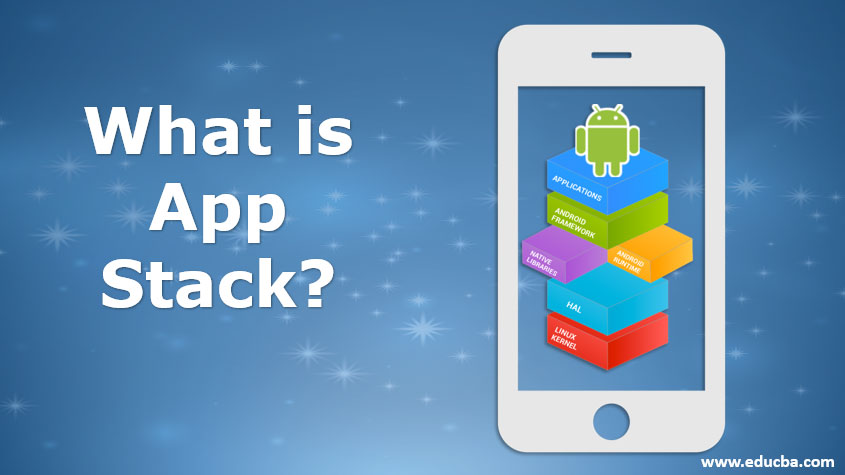Updated March 18, 2023
What is App Stack?
A stack is a community of software that works together to achieve a common objective. Typical code stacks contain software that is closely related and helps complete a specific task. The program stacks and device stacks should not be confused. A stack of applications offers workflow-enhancing programs which help manage tasks, while the software stack provides infrastructure rather than standard applications. On the other hand, the application layer provides a framework for working in a software stack to provide minimal interaction with the applications.
Attributes of App Stack
- All favorite applications of users can be seen under one app where the user can move between apps seamlessly.
- We can say that smartphones are made smarter with App Stack.
- Install App Stack into the device and login or register into the application.
- All the apps supported will appear on the launch screen of our app.
- Select from the apps listed, needed to the user, and give the corresponding app’s login details.
- This process is repeated until all the apps needed by the user are added into the App Stack.
- Once you are done with the app, it never logs out, and hence your data is stored securely.
- When all the apps the user needed is launched inside App Stack, apps outside is no longer needed. The user can uninstall the applications.
- Each application will behave in its own manner inside App Stack, and hence the functions are not compromised.
- It is not just an application; it is smarter than all other applications.
- Since many applications can be run at once, the office processes such as word, excel, the presentation can be easily carried out using this application.
- We can link the applications inside the Stack, and if needed, the data can be imported from one application to another.
- Also, it can be used to make the software work for a common goal after linking all the applications.
- An environment is provided by App Stack so that the apps can work together if needed for a common goal.
- Application programs ease the workflow and manage the tasks inside the App Stack.
- Apps are arranged in sequential order, and Stack works on the principle of LIFO, i.e. Last In First Out. When an application is inserted in the end, that app is taken out or evaluated first inside the App Stack. We cannot remove two or more applications at a time. Each application is evaluated and taken out individually.
- When many operations are carried out together, a queue is formed to select applications based on priority functions. Process scheduling is done in an efficient manner.
Top 15 Uses of App Stack
1. All the applications can be tracked well. Users can keep an eye if someone is using the phone and using the applications. The log of App Stack helps the user to get the data.
2. All the information about the functions of the app is known through App Stack.
3. The user can easily change from one application to another.
4. Backtracking is easily done, such as games, finding the path, searching for other applications and so on.
5. It helps in managing memory. Many languages can be managed with the help of App Stack. The memory is allocated dynamically.
6. Various expressions are evaluated, especially arithmetic expressions and control structures.
7. The prefix and suffix notations are identified and managed easily.
8. An Infix is translated or converted into Postfix easily.
9. When the user wants to search an application, Depth First Search (DFS) is done; also, full-stack searches are carried out.
10. Algorithms can be scheduled with the help of App Stack.
11. Hash tables are in App Stack so that it helps in fast data lookup. Data is represented uniquely using hash tables.
12. Word processing is easily done in this application. For this purpose, many virtual machines are used.
13. IP routing is another use. When routing is done, the network follows a specific pattern, and communication faces no disturbances between the networks.
14. Since many applications are working simultaneously, the user login page should show all the applications with prime importance, and computer graphics are another application. This is done with the help of computer graphics in 2D and 3D.
15. Graphs showing connections of the network, communication, data, organizing data, social networking sites’ data flow is shown and managed well inside App Stack.
Advantages
- Apps can be easily added and removed from the stack, which eases the operation of the application and hence the user.
- Hardware requirement for the Stack is less, and hence the cost of the application is less.
- It works in cross-platform. All the apps are managed inside App Stack, and it does not create any memory drawbacks.
- Memory management is a boon, and the users need not do anything related to memory. The App Stack’s CPU manages it by itself.
- It is easy to switch between applications and for developers to switch between client and server applications.
- Real-time demonstrations are done easily inside App Stack.
- It saves time since all the applications are stored inside the application, and the user need not worry about the same.
- If needed, the user can collaborate with the cloud, and the data will be safe for the user.
Conclusion
Due to dynamic memory allocation, the memory space should be utilized fully or else unused memory space will be an issue for the developers. Also, the flexibility of apps is less. Users should use this application so that the security is not compromised.
Recommended Articles
This is a guide to What is App Stack?. Here we discuss the different Attributes of App Stack and its Generous Advantages along with its Uses. You can also go through our related articles to learn more –


